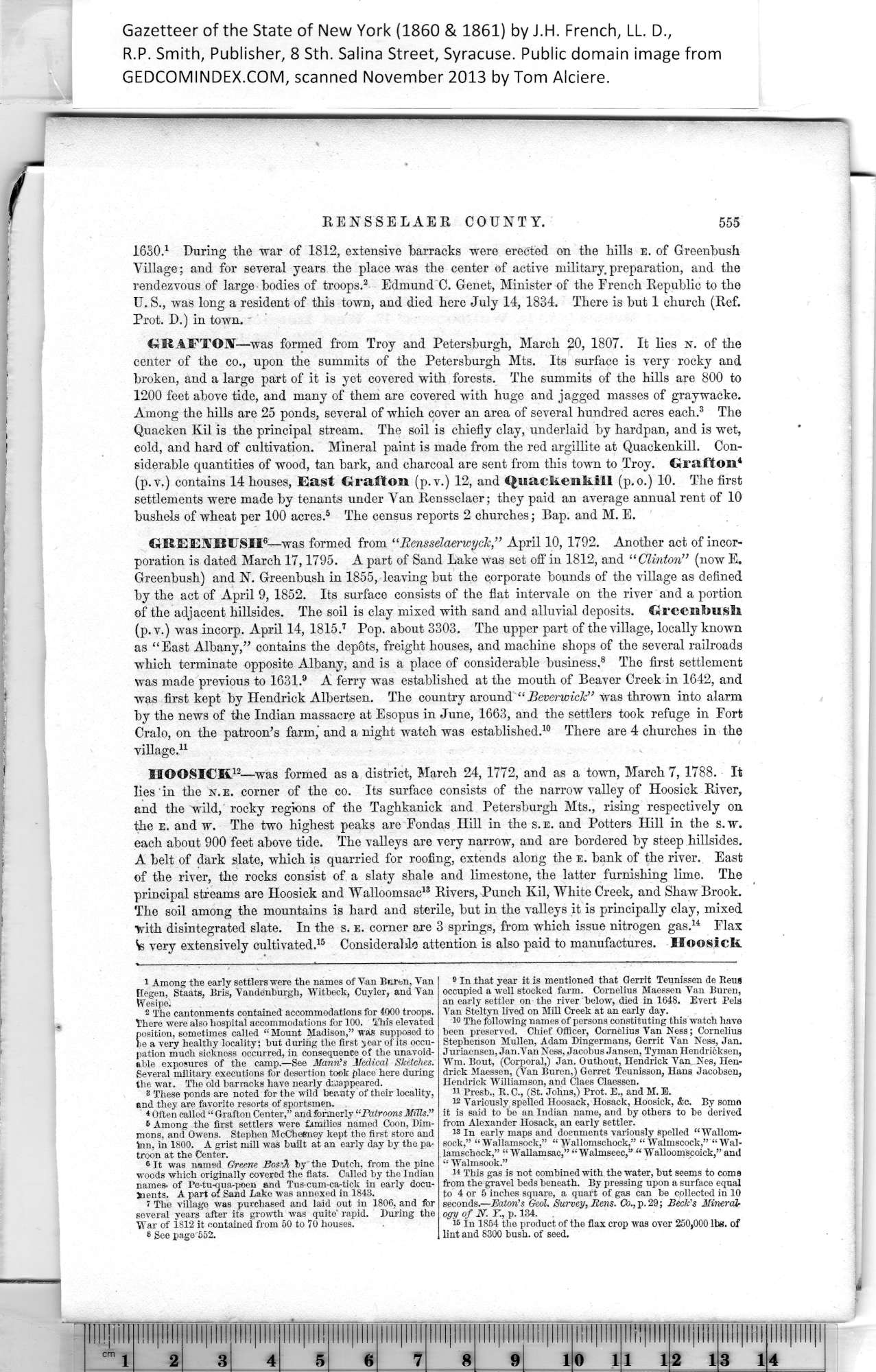|
RENSSELAER COUNTY. 555
1630.1 During the war of 1812, extensive barracks were erected on the hills e. of Greenbush
Village; and for several years the place was the center of active military, preparation, and the
rendezvous of large bodies of troops.2 Edmund C. Genet, Minister of the French Republic to the
U. S., was long a resident of this town, and died here July 14, 1834. There is but 1 church (Ref.
Prot. D.) in town.
GRAFTON—was formed from Troy and Petersburgh, March 20, 1807. It lies n. of the
center of the co., upon the summits of the Petersburgh Mts. Its surface is very rocky and
broken, and a large part of it is yet covered with forests. The summits of the hills are 800 to
1200 feet above tide, and many of them are covered with huge and jagged masses of graywacke.
Among the hills are 25 ponds, several of which cover an area of several hundred acres each.2 The
Quacken Kil is the principal stream. The soil is chiefly clay, underlaid by hardpan, and is wet,
cold, and hard of cultivation. Mineral paint is made from the red argillite at Quackenkill. Con¬
siderable quantities of wood, tan bark, and charcoal are sent from this town to Troy. Grafton*
(p.v.) contains 14 houses, East Grafton (p.v.) 12, and Qua,ckenkill (p.o.) 10. The first
settlements were made by tenants under Van Rensselaer; they paid an average annual rent of 10
bushels of wheat per 100 acres.5 The census reports 2 churches; Bap. and M. E.
GREENBFSH6—was formed from “Rensselaerwych,” April 10, 1792. Another act of incor¬
poration is dated March 17,1795. A part of Sand Lake was set off in 1812, and “ Clinton" (now E.
Greenbush) and N. Greenbush in 1855, leaving but the corporate bounds of the village as defined
by the act of April 9, 1852. Its surface consists of the fiat intervale on the river and a portion
of the adjacent hillsides. The soil is clay mixed with sand and alluvial deposits. Greentmsh
(p.v.) was incorp. April 14, 1815.7 Pop. about 3303. The upper part of the village, locally known
as “East Albany,” contains the depots, freight houses, and machine shops of the several railroads
which terminate opposite Albany, and is a place of considerable business.3 The first settlement
was made previous to 1631.9 A ferry was established at the mouth of Beaver Creek in 1642, and
was first kept by Hendrick Albertsen. The country around “ Bcverwick” was thrown into alarm
by the news of ihe Indian massacre at Esopus in June, 1663, and the settlers took refuge in Fort
Cralo, on the patroon’s farm,' and a night watch was established.10 There are 4 churches in the
village.11
HOOSICK.12—was formed as a district, March 24, 1772, and as a town, March 7, 1788. It
lies in the n.e. corner of the co. Its surface consists of the narrow valley of Hoosick River,
and the wild, rocky regions of the Taghkanick and Petersburgh Mts., rising respectively on
the e. and w. The two highest peaks are Fondas Hill in the s.e. and Potters Hill in the s.w.
each about 900 feet above tide. The valleys are very narrow, and are bordered by steep hillsides.
A belt of dark slate, which is quarried for roofing, extends along the e. bank of the river. East
of the river, the rocks consist of a slaty shale and limestone, the latter furnishing lime. The
principal streams are Hoosick and Walloomsac13 Rivers, Punch Kil, White Creek, and Shaw Brook.
The soil among the mountains is hard and sterile, but in the valleys it is principally clay, mixed
with disintegrated slate. In the s. e. corner are 3 springs, from which issue nitrogen gas.14 Flax
<6 very extensively cultivated.15 Considerable attention is also paid to manufactures. Hoosick.
|
8 In that year it is mentioned that Gerrit Teunissen de Reus
occupied a well stocked farm. Cornelius Maessen Van Buren,
an early settler on the river below, died in 1648. Evert Dels
Van Steltyn lived on Mill Creek at an early day.
10 The following names of persons constituting this watch have
been preserved. Chief Officer, Cornelius Van Ness; Cornelius
Stephenson Mullen, Adam Dingermans, Gerrit Van Ness, Jan.
Juriaensen, Jan.Van Ness, Jacobus Jansen, Tyman Hendricksen,
Wm. Bout, (Corporal,) Jan. Outhout, Hendrick Van Nes, Hen¬
drick Maessen, (Van Buren,) Gerret Teunisson, Hans Jacobsen,
Hendrick Williamson, and Claes Claessen.
11 Presb., B. C., (St. Johns,) Prot. E., and M. E.
12 Variously spelled Hoosack, Hosack, Hoosick, &c. By somo
it is said to be an Indian name, and hy others to be derived
from Alexander Hosack, an early settler.
18 In early maps and documents variously spelled “Wallom-
sock,” “Wallamsock,” “ Wallomschock,” “Walmscock,” “Wal-
lamschock,” “ Wallamsac,” “ Walmseec,” “ Walloomscoick,” and
“ Walmsook.”
14 This gas is not combined with the water, but seems to corns
from the gravel beds beneath. By pressing upon a surface equal
to 4 or 5 inches square, a quart of gas can be collected in 10
seconds.—Eaton’s Geol. Survey, Rens. Co., p. 29; Beck’s Mineral¬
ogy of N. T., p. 134.
is In 1854 the product of the flax crop was over 250,000 lhs. of
lint and 8300 hush, of seed. |
1
Among the early settlers were the names of Van B«.ren, Van
flegen, Staats, Bris, Vandenhurgh, Witheck, Cuyler, and Van
Wesipe.
2
8 These ponds are noted for the wild beaaty of their locality,
end they are favorite resorts of sportsmen.
3
See page'552.
|
